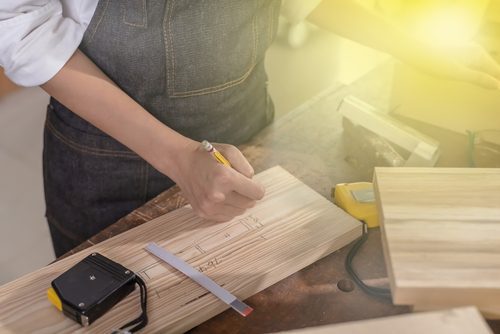Pressed flowers offer a beautiful touch to home décor and paper crafts, from scrapbooks to handmade cards. They can enhance handmade soaps and candles. With a DIY flower press, you can preserve your favourite blooms for an extended period. Create your own flower press with this step-by-step guide.
See also: How to make resin coasters?
Step-by-step guide to making a flower press

Gather the necessary tools and materials
You will need the following to make a flower press:
- 4 8×8 inch carriage bolts
- 2 12×10 inch wood pieces, at least1 inch thick
- 4 3/8 inch wing nuts
- Ruler
- Pencil or pen
- Piece of scrap wood
- Sandpaper
- Cardboard squares cut to fit the flower press
- Scissors or a box cutter
- Newspaper or printer paper cut to fit the flower press
- Paint
- Primer
- Paint brushes
- Circular saw (if you want to cut your own wood)
- 1/2 inch drill bit
- Drill
Select the wood
To kickstart this project, you will require two identical pieces of wood. To ensure the durability and stability of your flower press, opt for, at least, 1 inch thick wood. The exact measurements are at your discretion. A standard-size flower press is 12×10 inches but feel free to make it bigger to accommodate more flowers. If you have access to a power saw, cut the wood to your desired size. Or get it cut to your specified dimensions.
Mark the drilling path
Create a mark approximately an inch away from each corner on one of the wood pieces. These marks will serve as your drilling guides. Ensure that the marks are accurate and evenly spaced. Avoid placing the marks too close to the edges to prevent the drill from piercing through the side.
Start drilling
Once you have marked the drilling guides, stack the two wood pieces together. To enhance stability, clamp the pieces together. Position this stack on a piece of scrap wood. Utilising the marks as a reference, drill through both wood pieces. Aim for a clean, straight hole that penetrates both pieces.
Smoothen the edges
After drilling, gently sand away any rough edges on your flower press with sandpaper. Sand the newly drilled holes as well. Once done, wipe it clean to remove any dust or debris.
Paint your flower press
Painting your flower press can give it a unique appearance. You can use any paint suitable for wood. Consider using crackle paint for an interesting effect. It dries with small and large cracks on its surface. Start by applying a layer of crackle paint to one side of each wood piece. The thickness of the paint layer will determine the intensity of the cracks. Allow the painted flower press to dry in a warm, sunny location, following the manufacturer’s instructions for specific drying times.
Cut paper and scrap cardboard
While your flower press is drying, gather some scrap cardboard pieces. Cut these pieces to match the dimensions of your flower press, ensuring that they are slightly smaller than each wood piece. The cardboard should not extend beyond the edges of your DIY flower press. These cardboard pieces will serve as the base.
Use the cardboard as a template to cut paper for your flower press. You can repurpose old newspapers, printer paper or any available paper. Use a pair of scissors or a box cutter with a straight edge. The paper should be roughly the same size as the cardboard but it does not need to be an exact match.
Put flowers in the press
With two wooden pieces, cardboard and appropriately sized paper ready, you can begin pressing flowers. Place a few layers of paper on top of one piece of cardboard. Arrange your flowers on one of the paper layers, making sure they do not touch each other. If you prefer a collage effect, allow the flowers to overlap or touch. Place another layer of paper on top of the flowers and add the second piece of cardboard. You can create multiple layers of cardboard, paper and flowers to accommodate the number of flowers you want to press.
Screw carriage bolts
Before you use your homemade flower press, ensure that the painted wooden pieces are completely dry. Insert the carriage bolts into the holes on the wood piece that will serve as the bottom section. Place the stack of cardboard, flowers and paper on top of this piece and position the second wood piece on top of the stack, aligning the corner holes with the carriage bolts. Attach the wing nuts and gently press the top board down by hand, applying moderate pressure. Tighten the wing nuts but be cautious not to overtighten them.
Check how your flowers turned out
Position the flower press in a dry area where it will not be disturbed for the next seven days. After a week, it is time to check on your pressed flowers. Loosen the wing nuts and remove the top wood. Take off the cardboard and paper layers until you can assess whether the blossoms have dried properly. Depending on the type of flowers and the prevailing temperature and humidity levels in your location, the drying and pressing process may take up to two to three weeks. Nevertheless, it is advisable to start inspecting the press after the initial week.
FAQs
What can I use instead of a flower press?
If you do not have a flower press, you can create one using common household items. Gather materials like corrugated cardboard, paper towels or tissue paper, newspaper or blotting paper, heavy books, flat boards or bricks. Place your flowers and foliage between two layers of paper towels, tissue paper or any other type of thin, porous paper and place the entire arrangement between heavy books, flat boards or bricks.
How to make a cheap flower press?
To make an inexpensive flower press, insert two sheets of kitchen paper or tissue paper between the pages of a book. Carefully arrange your flowers and leaves on the paper add two more sheets of paper on top. If you have more flowers to press, repeat the process on different pages within the book.
What is the best material to press flowers?
When pressing flowers, you create a stack, resembling a sandwich. Begin with a sturdy piece of cardboard at the bottom, followed by at least five sheets of newspaper. Place a layer of blotting paper on top to absorb any excess moisture from the plants.
How do you preserve flowers without a press?
If you lack a flower press, consider preserving flowers individually. Hang each stem upside down in a dry, temperate location, such as a hallway closet. Allow all the blooms to air-dry for at least a week or longer if the environment is cooler.
Why are pressed flowers so expensive?
Pressed flowers tend to be pricier than fresh ones due to the additional effort required for their cultivation and preservation.
Which papers can I use to press flowers?
Opt for absorbent papers like coffee filters, parchment paper, blotting paper or watercolour paper. The moisture from the flowers could cause the pages to wrinkle so choose a book you would not mind damaging.
Is it better to dry or press flowers?
Drying is a versatile method for preserving flowers and can be used for all flower types. Drying is especially recommended for bouquets with flowers featuring round, bulbous blooms like carnations, roses, peonies or globe thistles as these can be challenging to press effectively.
| Got any questions or point of view on our article? We would love to hear from you. Write to our Editor-in-Chief Jhumur Ghosh at jhumur.ghosh1@housing.com |







